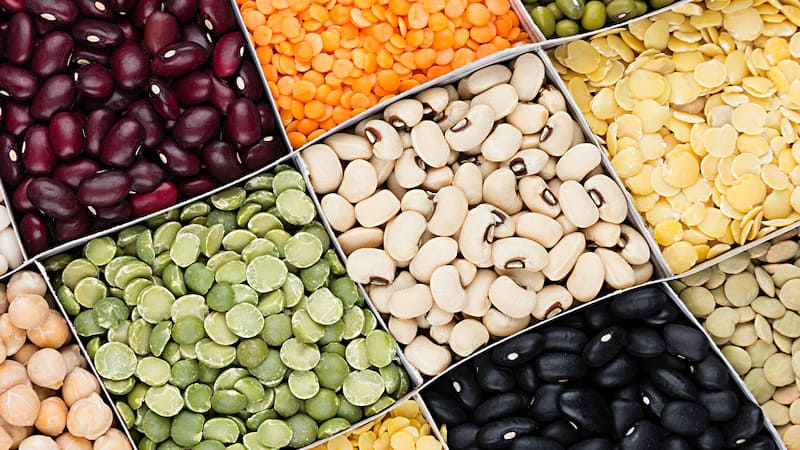Include Healthy Pulses in Your Diet
These easy, inexpensive meal ingredients deserve a nutritional high-five!

With plant-based eating on trend, you may have noticed that we are hearing more often about the health and environmental benefits of including pulses in your diet. Indeed, pulses have a lot going for them in terms of nutrition, sustainability, and affordability. Their use is emphasized by various healthy eating plans, including the famed Mediterranean Diet and the brain-benefiting MIND diet. Yet, few Americans are eating enough of them, let alone even know what a pulse is.
Here’s what you need to know about these small-but-mighty nutritional powerhouses.
What are pulses?
Pulses are the edible seeds of plants in the legume family. The word “pulse,” which hails from the Latin word puls, meaning thick soup, specifically refers to legumes that are grown and harvested for their dry seed. (While all pulses are legumes, all legumes are not pulses.) Pulses include chickpeas, beans, lentils, and dried peas such as split peas. Items like green beans and fresh peas aren’t classified as pulses.
Why are they so good for you?
“Pulses are considered nutrient-rich foods, meaning you get a lot of nutrition per calorie,” says Sharon Palmer, The Plant-Powered Dietitian, MSFS, RDN. She notes that their impressive nutrition package includes protein, fiber, vitamins, minerals, and antioxidants.
Just one-half cup of cooked pulses provides about nine grams of protein and seven grams of fiber. Palmer explains that this tag-team of fiber and protein increases satiety from a meal that includes pulses, which helps with appetite control. One study discovered that high-protein legume-based meals promote greater feelings of fullness and lower post-meal sensations of hunger than high-protein animal-based meals, which are much lower in fiber. The satiating factor of pulses might be a reason why there is some evidence to show they can aid in weight-loss efforts.
“The high amounts of fiber in pulses can also feed our gut microbes, which helps reduce inflammation, risk of chronic diseases, and improves immune function,” Palmer adds.
Pulses should be considered micronutrient dense — these legumes pack in high amounts of iron, magnesium, zinc, copper, potassium, and B vitamins such as folate and thiamine. This is why research data shows that consuming a relatively small amount of pulses daily — one-half cup — can improve overall diet quality. “Eating pulses regularly can certainly make it much easier for people to reach all their nutrient needs,” says Palmer.
Pulses also provide a dose of health-hiking antioxidants, such as the anthocyanins in black beans and black lentils that Palmer says can help reduce cell damage in the body and thereby lower the risk for several diseases, such as cancer and diabetes.
A handful of studies are backing up the claim that pulses are good for the body and longevity. For instance, a cohort study in the Archives of Internal Medicine looking at legumes including pulses and heart health, found that, after 19 years, people who ate legumes four or more times per week had a 22% lower risk of heart disease and 11% lower risk of cardiovascular diseases (stroke, heart attack) than those who consumed legumes less than once weekly.
Are there other benefits of including pulses in your diet?
First, these nutritional powerhouses are inexpensive.
“Pulses are one of the most nutrient-dense foods per dollar, meaning you fit in more nutrition in every dollar you spend, compared to other foods that may cost more, but deliver fewer nutrients,” says Palmer. For just a few dollars, you can buy enough dried pulses to make several servings. The precooked, canned versions are a slightly more expensive option, but they’re still a bargain source of nutrition compared to the cost of meat.
What’s more, pulses generally have a low carbon footprint and use significantly less water than many other foods, so eating them can increase the sustainability of your diet. They can also help minimize food waste, since pulses can be stored for long periods without losing their nutritional value or food safety concerns. The 2019 EAT-Lancet report that outlines a “planetary health diet” recommends 50 grams of legumes (about one-quarter cup) in the daily diet.
The most nutritious canned foods for your diet
How can your include more pulses in your diet?
Include a variety of pulses into your diet for different flavors and nutrition. Pulses can be included in many dishes, including soups, stews, pasta, salads, curries, spread, dips, like hummus, and even some desserts. Because of their “meaty” texture, pulses can stand in for animal-based foods in a variety of preparations, such as tacos, burgers, and meatloaf.
Most pulses, except for fragile lentils, like red lentils, benefit from soaking overnight in water to quicken the cooking time and improve digestive tolerance. “By soaking your dried pulses well (eight hours), draining off soaking liquid, adding fresh water, and cooking thoroughly, you can reduce the compounds that produce gas,” explains Palmer.
Reprinted with permission from Environmental Nutrition, a monthly publication of Belvoir Media Group, LLC. 800-829-5384. www.EnvironmentalNutrition.com.
©2023 Belvoir Media Group. Distributed by Tribune Content Agency, LLC. Premium Health News Service.


